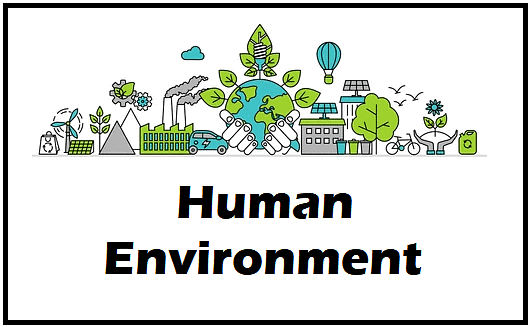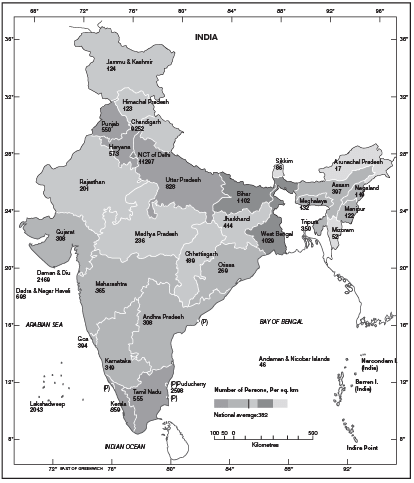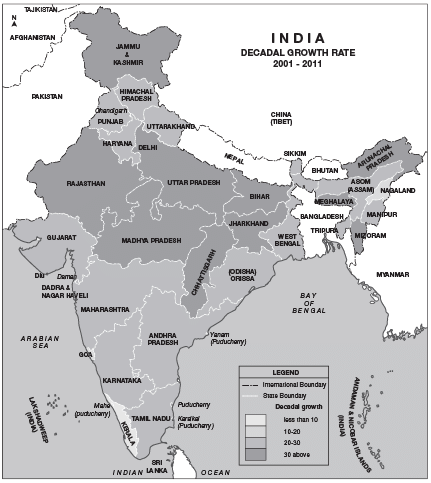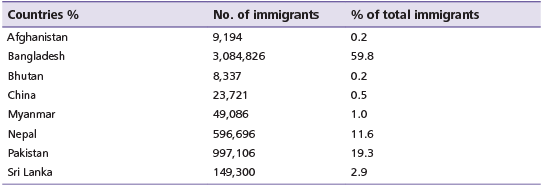Notes: Human Environment | Social Studies & Pedagogy Paper 2 for CTET & TET Exams - CTET & State TET PDF Download
Human environment is constituted by humans, their activities, and environmental features they have created for their convenience and comfortable life. How do they live, where do they live, their population, their mode of communication among themselves, and how they survive, all these questions are the matter of human environment. In this chapter, we will focus on certain aspects of human environment such as human settlements, migration, transportation, and population.
 Human EnvironmentPopulation
Human EnvironmentPopulation
When we think about the word population in the context of human beings, the few things that immediately come to our mind are people, specific geographical area, composition of different groups, density, distribution, and so on. These words have a very important role to define the status of population of a region, country, or continent. In this section, we will discuss about Indian population.- India is the second most populous country of the world, and China being the first. However, as we are growing very fast in numbers, we will definitely snatch the crown of world’s most populous country from China. At present, according to 2011 census, the total population of India is 1,210,726,932. As mentioned earlier, if we want to understand population, we have to focus on its different traits such as distribution, density, growth, and composition. Hence, first we will start with the concept of distribution in the way to understand Indian population.
Distribution of Population
India has unequal distribution of population. Some states have very high population and some have very less. Uttar Pradesh, Maharashtra, Bihar, and West Bengal are the highly populated states of India. States such as Sikkim, Jammu & Kashmir, Arunachal Pradesh, and Uttarakhand have very small share of population of the total population of India. There are various reasons behind this unequal distribution in India."Among the socioeconomic and historical factors of population distribution, the important ones are evolution of settled agriculture and agricultural development, pattern of human settlement, development of transport network, industrialisation, and urbanisation. It is observed that the regions falling under river plains and coastal areas of India have remained the regions of high population concentration. Even though the uses of natural resources such as land and water in these regions have shown the sign of degradation, the concentration of population remains high because of an early history of human settlement and development of transport network. On the other hand, the urban regions of Delhi, Mumbai, Kolkata Bangalore, Pune, Ahmadabad, Chennai, and Jaipur have high concentration of population due to industrial development and urbanisation drawing a large numbers of rural–urban migrants".
Ten highly populated states of India as per 2011 census are as follows:
- Uttar Pradesh: 199,812,341
- Maharashtra: 112,374,333
- Bihar: 104,099,452
- West Bengal: 91,276,115
- Madhya Pradesh: 72,626,809
- Tamil Nadu: 72,147,030
- Rajasthan: 68,548,437
- Karnataka: 61,095,297
- Gujarat: 60,439,692
- Andhra Pradesh: 49,386,799
Ten less populated states of India as per 2011 census are as follows:
- Sikkim: 610,577
- Mizoram: 1,097,206
- Arunachal Pradesh: 1,383,727
- Goa: 1,458,545
- Nagaland: 1,978,502
- Manipur: 2,721,756
- Meghalaya: 2,966,889
- Tripura: 3,673,917
- Himachal Pradesh: 6,864,602
- Uttarakhand: 10,086,292
Population of union territories of India as per 2011 census are as follows:
- Delhi: 16,787,941
- Puducherry: 1,247,953
- Chandigarh: 1,055,450
- Andaman and Nicobar Islands: 380,581
- Dadra and Nagar Haveli: 343,709
- Daman and Diu: 243,247
- Lakshadweep: 64,473
Density of Population
Density of population means number of persons per unit area. According to 2011 census, the density of India’s population was 313 people per square km, but the estimated density of India’s population was 383 people per square km. Similar to distribution of population, density of population is also unequally distributed in India. There are few places in India where density of population is very high. Arunachal Pradesh, New Delhi, West Bengal, Bihar, and Uttar Pradesh are the highest dense areas. On the other hand, there are some very low density areas such as Himachal Pradesh, Uttrakahand, and Andaman and Nicobar Islands. India density of population 2001
India density of population 2001
Growth of Population
Growth in population means positive change in the number of people living in a specific area. For measuring the growth in population, we have to decide any specific time period. ‘Population growth has two components, namely natural and induced. The natural growth is analysed by assessing the crude birth and death rates, whereas the induced components are explained by the volume of inward and outward movements of people in any given area’. The growth rate of Indian population is very high. We can understand it by seeing the map shown:
 India growth of population
India growth of population
Composition of Indian Population: Composition of Indian population is very diverse in nature. These are multiple religions, tribes, languages, ethnicities, and so on. If you want to understand the composition of Indian population, you have to analyse all different traits of Indian population such as age, sex, ethnicity, religion, language, marital status, literacy, occupation, and so on.
Settlements
Settlement in Geography is an important sub-branch of human geography. The group of houses built by the people to live can be called a settlement. To be considered as a settlement, the places where such houses are built must have an independent name. If small places where such houses are built do not have an independent name, then it is considered as a subpart of the big settlement, and such settlements are called hamlet. Sometimes the word settlement is used for the place having a specific geographical area and people may or may not live there. The settlements where people do not live are called uninhabited settlements. The human settlements are the result of human interactions with their environment. People build home for shelter and safety from wild animals, weather, and from other people. However, these alone do not make a settlement. Actually the settlements are the result of people’s cooperation and their ability to develop and use the available environmental resources. The settlements are developed with the development of human civilisation from hunting–gathering to agriculture, which demanded help of others and mutual cooperation. The area where the settlement extends is called its site. The settlements are dependent on some natural conditions such as climate, water availability, suitable land, and fertile soil.On the basis of their location, time of staying, and building features, the settlements can be classified as follows:
- Rural settlement: The rural settlements are settlements whose residents are primarily engaged in the primary economic activities such as animal husbandry and agriculture. For these activities and for most of their requirements, the people mainly depend on the primary resources available in the local environment. Most of the rural settlements are smaller than the urban settlements.
- Urban settlement: The urban settlements are relatively bigger and are thickly populated than the rural settlements. The economics and commercial activities of the urban settlements are complex and diverse. Most of the population of the urban settlements is engaged in the secondary activities or the service sector of the economics such as production, transportation, trade and commerce, and so on. The urban population is dependent on the rural population to fulfil its food and consumption products.
- Temporary settlement: As the name itself specify, the temporary settlement is a place where human live for a relatively short period of time. This could be a result of staying for a particular purpose that may not exist after a specific time. For example, some communities, who involve in hunting and gathering, build their homes in a jungle for a particular period of time to live safely during their stay, and this creates a temporary settlement. They can remove their shelter after the purpose is fulfilled, which could be killing and gathering of fishes, migratory birds, animals, seasonal fruits, woods, flowers, and so on. These kinds of settlements are in trend among the communities living in the jungle and practicing shifting cultivation, hunting and gathering, and so on. The geographical distribution spread in vast area and can vary from place to place such as desert will vary from jungles and jungles will vary from the poles.
- Permanent settlement: The settlements where people live permanently are called permanent settlements. Unlike the temporary settlements, people live in these settlements for a long period of time. The permanent settlements design the nature of shelter like solid concrete buildings, and so on. The permanent settlement also requires some facilities to live life comfortably. The area where a permanent settlement exists is surrounded by facility providers such as markets, schools, institutions, hospitals, and so on to fulfil the daily requirement of the residents. The settlers are also required to travel from one place to another, so they need means of transportation and communication.
- Clustered settlements: In this type of settlement, the houses of the people are found very close to one another. The limited supply of water, need for safety, fertile soil, unstable sociopolitical situations, and so on are the main causes of formation of this kind of settlements. The density of population of these settlements is generally high. This kind of settlements is found in India, China, Pakistan, and Middle East countries of Africa.
- Scattered settlements: In this type of settlement, the houses are very far from each other, and the reasons of formation of this kind of settlements are opposite of the clustered settlements. The unlimited water availability, safety, large and fertile fields, and stable and peaceful sociopolitical situations are the main causes of existence of scattered settlements. This kind of settlements is found in North America, Australia, and some parts of Europe.
- Segmented settlements: This kind of settlement shows the transition of the scattered and clustered settlements. This is formed by the grouping of many houses. The group of houses shares a similarity and there is a difference among them. They could be formed on the basis of same religion, language, cultural milieu, and so on.
Transport and Communication
1. Road TransportIt is the most accessible and commonly used means of transport. However, its development is not equal all over the world. Surface and distribution of population plays a very vital role in the development of road transport. Now, in the present world, road transport not only confines with the local and national boundaries but also plays an important role in international and intercontinental transportation. Northern America and Europe has developed such kind of network.
2. Train Transport
Train transport is a very important part of land transportation. It is very useful for long distance transportation. The development of train transportation is the gift of industrialisation. The development of train transport is based on the surface conditions and distribution of population. In planes, it is very easy to develop a railway network, but in hills and high places, it becomes very tough to establish a network of train transportation. Although train transportation is developed in every part of world, the most important train networks are those that connect a nation to another nation or very long distant areas within a nation. The railways are developed after the roadways. The first railways were developed in England in 1835 and the first train ran between the Manchester and Liverpool, and its driver and builder was George Stephens himself. Most of the railways of the world are found in the Eastern Europe and Middle East of North America. USA has the longest rail route and India has the second longest railways in the world. Indian Railways network comprises 115,000 km of track over a route of 65,808 km of route with 7112 stations. In India, the first train ran between Mumbai to Thane in 1853. It was nationalised in the year 1951. About 32.8 per cent of the route of Indian railways is electrified. It is the world’s seventh largest utility employer with a population of 1.376 million employees.
Some of the world’s famous train routes are as follows:
- Trans-Siberian train railway route (Russia)
- The Canadian: Toronto to Vancouver (Canada)
- Shanghai to Lhasa (China)
- California Zephyr: Emeryville (San Francisco) to Chicago
- Indian Pacific: Sydney to Perth (Australia)
- Vivek Express: Dibrugarh to Kanyakumari (India)
3.Water Transportation
Although water transportation is considered as the slowest transportation, its low cost makes it a very important transportation for inter-country transportation. It can be divided into two main categories, namely inner water transportation and sea water transportation.
Inner water transportation includes rivers, lakes, and canals. The importance and utility of these water routes depends on the depth, width, and amount of water of these routes. Some important water routes are as follows:
- Amsterdam-Rhine, Netherlands, 45 mi, 1952
- Beaumont-Port Arthur, United States, 40 mi, 1916
- Canal du midi, France, 149 mi, 1692
- Houston, United States, 50 mi, 1914
- Nord-Ostsee-Kanal, Germany, 61.3 mi, 1895
- Panama, panama, 50.7 mi, 1914
- St. Lawrence Seaway, US and Canada, 2400 mi, 1959
- Suez, Egypt, 119.9 mi, 1869
Migration
The term migration basically refers to the movement of people to one place to another. The movement of people could have certain reasons related to their social life, economical condition, situation of war and conflict, and so on. We can divide migration into two different types. The first is international migration and the second is internal migration. Again, we can divide internal migration into various types such as rural area to urban area, urban area to urban area, and rural area to rural area. In the context of India, we can also add a type of migration which is called state migration. In this chapter, we will try to understand the concept and tradition of migration in India.- ‘In the census of India, migration is enumerated on two bases:
(i) place of birth, if the place of birth is different from the place of enumeration (known as life-time migrant);
(ii) place of residence, if the place of last residence is different from the place of enumeration (known as migrant by place of last residence). Can you imagine the proportion of migrates in the population of India? As per 2001 census, out of 1029 million people in the country, 307 million (30 per cent) were reported as migrants by place of birth. However, this figure was 325 million (31 per cent) in case of place to last residence’. - When we talk about internal migration in India, we can easily find many different streams of migration. We can divide these streams in two broader categories: first is intrastate migration and second is interstate migration. Both these categories have four types of migration steams such as the following:
- Rural to rural: When people moved from one village to another.
- Rural to urban: When people moved to city from village.
- Urban to rural: When people moved to village from city.
- Urban to urban: When people moved from one city to another.
Immigrants from Neighbouring Countries
India is surrounded by almost seven countries. From some of these counties, India faces regular illegal intrusion. We can easily understand it by data given in Table;
 Immigrants by last residence from neighbouring countries by all duration in India, 2001Reasons for Migration
Immigrants by last residence from neighbouring countries by all duration in India, 2001Reasons for Migration
There are multiple reasons of migration of people in India. Here are some important reasons of migration in India.
- Work/employment: Work or employment is one of the most important reasons of migration. We can understand it by understanding industrial and infrastructural growth of India in the past few decades. If we investigate the last few decades of development in India, we can easily find that the last few decades’ development became centralised in very few regions of India. Jobs became bounded in specific cities. Hence, a person who needs an employment must come to a city such as Delhi, Mumbai, Pune, Chennai, Kolkata, and so on. Census 2001 clearly says that almost 38 per cent of total male migration in India is due to work or employment.
- Business: Business is also an important reason of migration of people. However, this is a very limited type migration. If we talk about 2001 census, business migration only contributes 3 per cent of total male migration in India.
- Education: Education is also the reason behind migration in India. According to 2001 census, it contributes almost 6 per cent in total male migration in India.
- Marriage: Marriage is one of the very big reasons of female migration in India. According to 2001 census, it contributes almost 65 per cent in total female migration.
- Natural disaster: Sometimes natural disasters such as earthquake, tsunami, flood, and drought become the reason of migration of people. These types of migration could be temporary or permanent or both.
- Social exclusion: In some cases, social exclusion becomes the reason behind movement of a group of people from one place to another.
Consequence of Migration:
There are some consequences of migration of large number of people. Cities become over crowded. Physical and social environment become pressurised. Over-exploitation of resources starts to fulfil the needs of population. The level of ground water drops down due to over depletion. Natural ecosystem of that place becomes affected badly.
|
75 videos|322 docs|78 tests
|
















